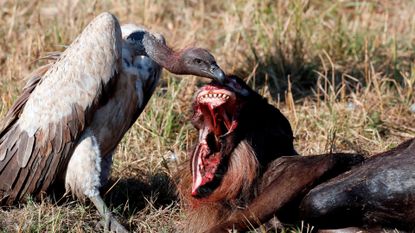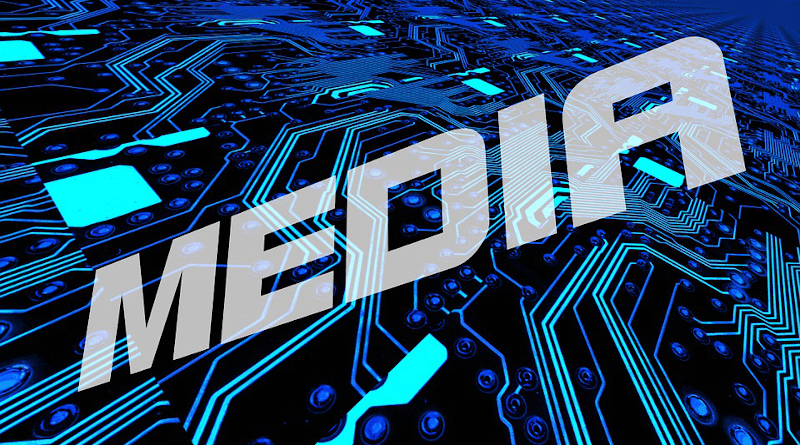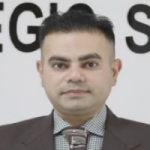By Charlie Northcott,
JULY 22,2024
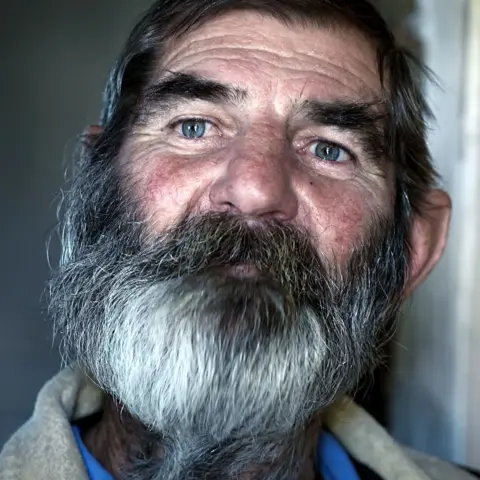
A convicted South African murderer who shot dead dozens of black men during apartheid has told the BBC the police sanctioned his violence. Louis van Schoor says others should share the blame for the killings he carried out as a security guard. But in talking to BBC Africa Eye over the past four years, he has also let slip horrifying details that raise serious questions about his early release from prison.
Standing in the bedroom of a killer, your eyes naturally hone in on the details.
Van Schoor’s bed is immaculately neat - the duvet so flat it looks like it has been ironed. The air is heavy with the smell of cigarettes, their stubs piled high in an ashtray. Strips of sticky paper are dangling from the ceiling, writhing with trapped and dying flies.
The so-called “Apartheid Killer” has lost his teeth. His health is waning. Following a heart attack, both his legs were recently amputated, leaving him in a wheelchair, with painful scars. When his surgeon carried out this procedure, Van Schoor requested an epidural instead of a general anaesthetic - so he could watch them remove his legs.
“I was curious,” he said, chuckling. “I saw them cutting… they sawed through the bone.”
In speaking to the BBC World Service, Van Schoor wanted to persuade us that he is “not the monster that people say I am”. His enthusiastic description of his legs being removed did little to soften his image.
Over a three-year period in the 1980s under the country’s racist apartheid system - which imposed a strict hierarchy that privileged white South Africans - Van Schoor shot and killed at least 39 people.
All of his victims were black. The youngest was just 12 years old. The killings occurred in East London, a city in South Africa’s windswept Eastern Cape.
Van Schoor was a security guard at the time, with a contract to protect as many as 70% of white-owned businesses: restaurants, shops, factories and schools. He has long claimed that everyone he killed was a “criminal” who he caught red-handed breaking into these buildings.
“He was a kind of vigilante killer. He was a Dirty Harry character,” says Isa Jacobson, a South African journalist and filmmaker, who has spent 20 years investigating Van Schoor’s case.
“These were intruders who were, in a lot of cases, pretty desperate. Digging through bins, maybe stealing some food… petty criminals.”

The Apartheid Killer
Watch on iPlayer (UK only) or on Monday 22 July at 23:05 on BBC Two (Northern Ireland 23:35).
Outside the UK, watch on the BBC Africa YouTube channel.

Van Schoor’s killings - sometimes several in a single night - struck terror into the black community of East London. Stories spread through the city of a bearded man - nicknamed “whiskers” in the Xhosa language - who made people disappear at night. But his shootings were not carried out in secret.
Every killing between 1986 and 1989 was reported to the police by Van Schoor himself. But the release from prison of anti-apartheid leader Nelson Mandela in 1990 signalled an end to this impunity. Ripples of change swept across South Africa and, following pressure from activists and journalists, the security guard was arrested in 1991.
Van Schoor’s trial was one of the largest murder trials in South Africa’s history, involving dozens of witnesses and thousands of pages of forensic evidence.
However, the case against him largely collapsed in court. At the time of his trial, much of the apparatus of the apartheid system was still in place within the judiciary. Despite killing at least 39 people, he was only convicted of seven murders. He would go on to serve just 12 years in prison.
His other 32 killings are still classified as “justifiable homicides” by the police. Apartheid-era laws gave people the right to use lethal force against intruders if they resisted arrest or fled once caught.
Van Schoor relied heavily on this defence to maintain his innocence, claiming that his victims were running away when he killed them.
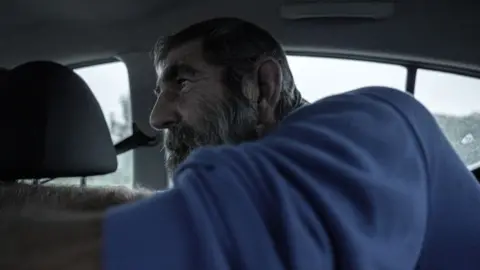
Louis van Schoor pointed out the places where he would track down intruders
The BBC’s investigation into Van Schoor scrutinised the evidence underlying these so-called “justifiable” shootings, delving deep into long-forgotten police reports, autopsies and witness statements.
The investigation was led by Isa Jacobson, and involved years of archival research in multiple cities across the Eastern Cape. The most important files were scattered among hundreds of boxes, hidden away in vaults.
“The whole scale of it is just mesmerising,” she said. “It's astounding that any court of law could allow this to happen.”
Some of the most harrowing evidence Ms Jacobson found were witness statements from people who were injured by Van Schoor, but survived. These accounts contradict the security guard’s argument that they had been running away when he shot them.
Multiple people said Van Schoor shot them while their hands were up, after they had surrendered. Others describe him toying with them, asking if they would prefer to be arrested or shot - before shooting them in the chest. Another victim described being shot in the abdomen, begging for water, before being kicked in his wound by Van Schoor.
The security guard was armed with a 9mm semi-automatic pistol, frequently loaded with hollow-point bullets, which cause severe internal ruptures when entering a victim. In one case, he fired eight shots into an unarmed man.
In a particularly brutal case on 11 July 1988, Van Schoor shot a 14-year-old boy who had broken into a restaurant searching for petty change.
The boy - who we have not named to protect his privacy - told the police he hid in the toilet when he saw Van Schoor with his gun. He says the security guard called him out, told him to stand next to the wall, and then shot him repeatedly.
“He told me to stand up, but I couldn’t,” said the boy, in his recorded testimony. “While I was lying there, he kicked me in the mouth. He picked me up and propped me up against a table and then he shot me again.”
The boy survived, but he was not believed. He was charged for breaking into the building. Many young black men and boys who gave first-hand accounts of being assaulted and shot by Van Schoor faced a similar fate.
Testimonies such as this were heard during Van Schoor’s trial, but the judge repeatedly dismissed the witnesses as “unsophisticated” and “unreliable”. There are no jury trials in South Africa. The opinion of the judge is final.

World of Secrets, Season 3: The Apartheid Killer
A new six-episode season from the BBC’s global investigations podcast. A BBC World Service investigation.
Listen now on BBC Sounds. If you are outside of the UK click here.

At the time of Van Schoor’s trial, many members of the white community in East London supported him. One entrepreneurial businessman printed bumper stickers with pictures of the security guard. They said “I Love Louis”, next to a heart full of bullet holes.
“There was evident racial bias in the legal system,” says Patrick Goodenough, a South African journalist who led the 1980s investigation into Van Schoor. He also attended his trial.
“The support for him was massive… He would not have been able to get away with a fraction of what he got away with without it.”
There is no statute of limitations for murder or attempted murder in South Africa. In theory, there is nothing stopping the police from reopening Van Schoor’s case and re-assessing these “justifiable” shootings.
“Louis van Schoor was basically going out and murdering people for sport,” says Dominic Jones, a journalist who helped raise awareness of the security guard’s killing spree in the 1980s.
Some of the most shocking findings from the BBC's investigation came from interviews with Van Schoor himself, which strongly suggested he got a thrill from his activities.
“Every night is a new adventure, if you want to put it that way,” he told the BBC.

Journalist Isa Jacobson has spent years going through public records to scrutinise Louis van Schoor's case
Many of the businesses he protected installed silent alarms. When someone broke in, Van Schoor would receive an alert which allowed him to surprise the intruder - and identify exactly where they were inside the building. And he always went alone.
“I was barefoot. It’s quiet. You don’t have your shoes squeaking on tiles and stuff,” he said.
He would never switch the light on. Instead, he relied on his sense of smell.
“If somebody breaks in, the adrenaline gives off an odour. And you can pick that up,” he said.
Van Schoor claims he never went out “with the intention of killing black people” and says he is not a racist. But he admits he found stalking them in the dark “exciting”.
Before becoming a security guard, Van Schoor was a member of the East London police force for 12 years. He used to handle what he calls “attacker dogs”, which he used to track down and catch protesters and criminals - almost all of whom were black.
He compared this to “hunting, but a different species”.
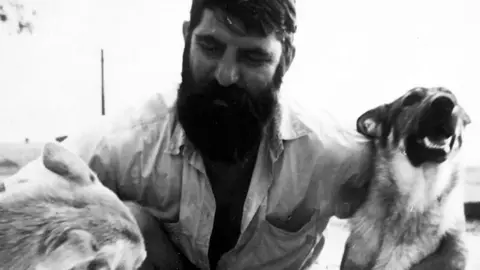
Louis van Schoor was previously in the police dog squad
Tetinene “Joe” Jordan, a former anti-apartheid activist who was operating in East London at the time of Van Schoor’s killings, remembers this well.
“He was hunting, literally hunting people,” he says.
Van Schoor strongly denies he is a “serial killer” and believes everything he did was “within the law”. If people feel aggrieved over his killings, he says they should blame the South African police.
He says the police never criticised or warned him, but actively supported and encouraged him.
“Every officer in East London knew what was going on… all the police officers knew,” he said. “Not once did anybody say ‘Hey Louis, you’re on the borderline or you should cool it or whatever’… they all knew what was happening.”
In the police records held in public archives, Ms Jacobson found instances of killings where officers had been present at the time of the shootings. At no point did they appear to question Van Schoor as a suspect.
In many instances, the police failed to take photos of the deceased at the scenes of shooting and failed to collect key forensic evidence, such as bullet casings. Van Schoor was often the only witness to his shootings, so this evidence could have been crucial for determining what had actually happened in each case.
“These were cover-ups… He had the backing from police officers from junior rank and senior rank,” said Mr Goodenough.
“They wouldn’t investigate. They’d sit down with him and have a cigarette while chatting, with bodies lying nearby.”
In all cases Van Schoor pulled the trigger - but between the police and the businesses that hired him, an entire community played a role in the killings which took place in East London.
“Van Schoor was a serial killer because there was a society that allowed him to be one,” says Ms Jacobson.
For the relatives of Van Schoor’s victims, his freedom, and the failure of the state to thoroughly investigate his killings, is a constant source of pain. Some never recovered the bodies of their loved ones.
“It seems like we are stuck in this phase of being heartbroken, being angry,” says Marlene Mvumbi, whose brother, Edward, was murdered by Van Schoor in 1987. His remains were dumped in an unmarked grave by the authorities without the family’s consent.
“Lots of people are still missing and not even in the graveyard… there is no closure.”
Van Schoor’s case pre-dated South Africa’s 1995 Truth and Reconciliation Commission, which gave compensation to many victims of apartheid-era crimes.
Sharlene Crage, a former activist who played a key role in pressuring the South African authorities to prosecute Van Schoor, is outraged that he was ever allowed to walk free.
“It’s a shocking miscarriage of justice,” she said. “There is no reason his case shouldn’t be reopened.”
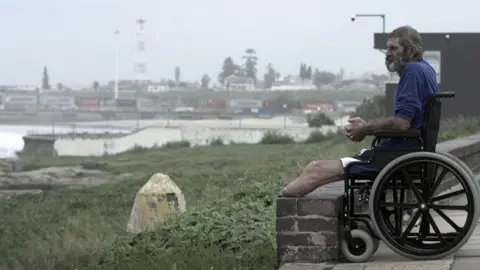
Louis van Schoor admitted he found tracking intruders down thrilling
Van Schoor was sentenced to more than 90 years in prison at the conclusion of his trial in 1992, but the judge allowed him to serve each term concurrently. He was freed on parole in 2004.
The early release of apartheid-era killers from prison has become a contentious issue in South Africa.
In 2022, there were protests in Johannesburg over the parole of Janusz Walus, who killed anti-apartheid politician Chris Hani. A few years previously, Eugene de Kock, in charge of a death squad responsible for the abduction, torture, and murder of dozens of black activists was also freed.
Nowadays, Van Schoor spends most of his time watching rugby, smoking and playing with his pet rottweiler, Brutus. He says he has no memory of many of his killings.
Some reports have stated, without verification, that he shot as many as 100 people. Van Schoor denies this, but concedes his number of shootings may exceed the documented number of 39.
“I honestly don’t know how many I shot. Some say over a 100, some say 40… Let’s say for argument’s sake I shot 50 people,” he told us.
He says he is proud of his past actions.
“I don’t feel any guilt,” he said. “I’ve got no remorse inside.”
The BBC contacted the South African police for comment, but they did not respond. The authorities have given no explanation for why Van Schoor’s killings have not been reassessed in the post-apartheid era.
“There is too much pain, and for now I don’t feel that there is enough that is done for us to heal,” says Marlene Mvumbi.
“It’s not only the ones that were killed by Van Schoor. The ones that have similar stories from the killings of the apartheid regime.”
Investigation by Isa Jacobson and Charlie Northcott








